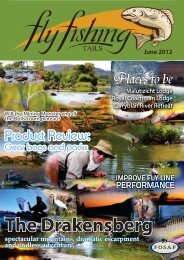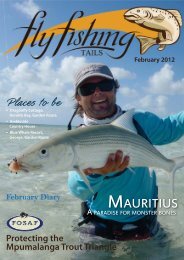NIGHT FLY FISHING EXPERIENCE - Flyfishingtails
NIGHT FLY FISHING EXPERIENCE - Flyfishingtails
NIGHT FLY FISHING EXPERIENCE - Flyfishingtails
You also want an ePaper? Increase the reach of your titles
YUMPU automatically turns print PDFs into web optimized ePapers that Google loves.
12<br />
ORVIS <strong>FLY</strong> <strong>FISHING</strong><br />
HOW TO PREVENT ROD<br />
Orvis goes to great lengths to prevent rod breakage. They<br />
invest in the highest quality carbon and thermoplastic resins<br />
to create rods that are light, responsive and durable. They<br />
utilize very sophisticated testing machines to ensure that the design<br />
of each rod will withstand breakage under all fishing conditions.<br />
They carefully inspect every rod before it leaves their Vermont rod<br />
shop, and every rod model undergoes hundreds of hours of field<br />
testing before they begin production. They feel so strongly about<br />
the quality of Their rods that all premium rods come with a 25-year<br />
guarantee against breakage for any reason.<br />
While the 25-year guarantee and the confidence that your rod will<br />
be repaired or replaced adds comfort, a broken rod can definitely<br />
put a damper on a trip. So here are a few tips to help prevent rod<br />
breakage.<br />
• Make sure your ferrules are properly seated throughout the<br />
day. Loose ferrules create unnecessary stress at critical points<br />
in the rod. Attach rod sections at a 45-degree angle and push<br />
them together with a slight twist to align. This ensures that<br />
your rod ferrules are well seated. Throughout the day, occasionally<br />
take the time to check that your ferrules are still tight.<br />
Over the season apply ferrule wax (included in all new rods) or<br />
regular candle wax to ensure a snug fit. This will greatly reduce<br />
your chance of a rod break.<br />
• Take care in your casting, when using weighted flies, streamers,<br />
or split shot, that you don’t hit the rod with your fly or<br />
weight. Weighted flies travel at amazing speeds; when they hit<br />
a rod tip they can cause a slight fracture in the carbon, increasing<br />
your chances of a break. Water loading, roll casts, sidearmed<br />
casts, and paying attention to the wind will help prevent<br />
collisions between your flies and the rod.<br />
• When stringing your fly line through your rod, take care<br />
that you do not pull on the line while the rod is at a<br />
steep angle. Fly rods are designed to have the force of<br />
the fly line distributed over the entire rod. This is why a







